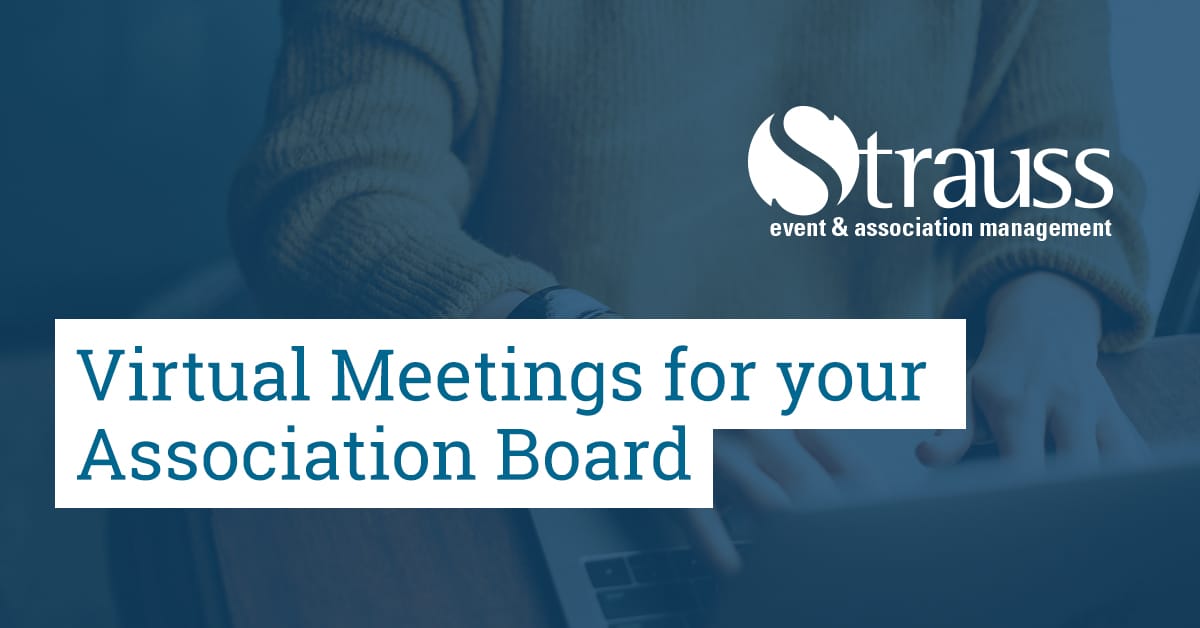With many people currently working from home, the need for association staff and volunteer leaders to work online is necessary in today’s environment. Association meetings, whether they are board or committee meetings, and the need to hold in-person meetings weekly, monthly, or quarterly has not changed; the way in which we hold these meetings has. Meetings can be postponed or canceled, but that cannot go on for too long as the work of the association must continue.
Since the pandemic, have your association meetings changed? In this article, I will be discussing how to make the most out of your association’s virtual meetings – what are the options available, advantages, risks, and general tips for holding virtual association meetings.
What Meeting Options are Available?
As an association board, if you host meetings monthly or quarterly and now can no longer meet in person, what are your options?
- Postpone the meeting until a future date
- Hold the meeting via teleconference
- Hold the meeting via web-conference or videoconference (Teams, Zoom, etc.)
Advantages and Risks of Virtual Meetings
Some advantages of hosting a virtual meeting are:
- More efficient
- More focus from board members
- No time for side talk; with in-person meetings, members often chat with the person sitting beside them
- No interruptions
There are some risks associated with holding virtual meetings, such as poor internet connections, losing internet during the meeting and/or audio not working. However, the advantages outweigh the risks.
It is important as the chair to keep members engaged and focused during the meeting, this can be done by having the shorter agenda than a normal in-person meeting and by asking questions and opinions from all members.
Before the Virtual Meeting
Prior to the virtual meeting, association board members will need to know/have the following information:
- Clear instructions on how to access the meeting; these should be provided a few days in advance to ensure all directors are ready to join when the meeting is scheduled
- The link to meeting should be very prominent in both the meeting invitation and on the agenda. Whenever possible, include options to call in as well as join online, since not everyone may have access to online options
- Links to technical help
- Reminders – members download the program ahead of time, and login early
- Meeting package materials a minimum of five days in advance. Meeting package includes the agenda with links to supporting documents, minutes of the previous meeting, committee reports, financial statements, briefing materials on any matters that require a vote. This allows board members to think ahead of what questions they have on topics and be prepared for discussion. For further information on preparing and creating a board meeting agenda, please view a previous article.
During the Virtual Meeting
The Chair of the board is in charge of running the meeting. It is a good idea to have a designated support to the chair to help monitor the chat box, Q&A, note who would like to speak. This designated support could be the Executive Director or Secretary.
Set expectations and norms. Your agenda has a start time and it needs to begin on time. It is understandable that sometimes a board member will run late due to a work priority, so do not feel as if you have to wait for everyone to login before starting the meeting. If you continuously push back your meeting start time, you will encourage board members to arrive later and later. Starting every meeting on time will communicate the importance of punctuality.
Consider using an online tool, such as Zoom or Microsoft Teams, where the chair or staff can mute and unmute speakers to ensure all directors can contribute and to control any background noise. These tools allow for screen sharing which can be useful for sharing the agenda and presenting documents.
When the meeting starts, provide a quick overview of the options and commands like how to unmute, show video function, chat box, Q&A area, etc. This ensures that everyone who needs to participate has the tools to do so.
Record the meeting and advise the attendees that it will be recorded if their camera is turned on. Recording video is helpful for the person taking minutes, especially if the meeting has lots of motions and action items. Some associations have policies that forbid the recording of meetings and this should be checked.
Group Update/Check-In
Ask how everyone is feeling and doing both personally and professionally during these times. Ensure that everyone feels connected in the community and that help is available should they need it. I recently attended a meeting where the chair asked each person how they were doing. It was such a great way to end the meeting and I really felt connected to everyone. An association can also gain key insights into their profession or industry from these updates.
As you can see there is a lot of information to consider when holding an association virtual meeting. Hopefully these tips can help you streamline the process and make your next virtual meeting a successful one.
View these articles for more information on association boards:
https://strauss.ca/board-succession-planning-during-a-pandemic-how-is-your-association-adapting/
https://strauss.ca/navigating-the-pandemic-as-a-board-chair-an-interview/
https://strauss.ca/ten-tips-how-to-be-a-good-efficient-board-member/
Information for this article was from a webinar I attended – Planning and Facilitating Virtual Meetings, Including Your AGM presented by Volunteer Manitoba.

